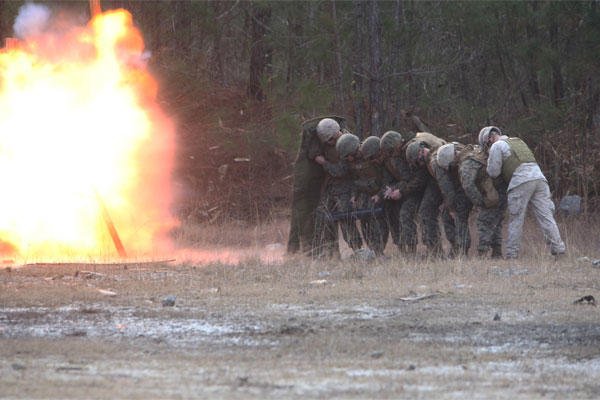CAMP LEJEUNE, N.C. -- The front door disintegrated into small, wooden shards and burning embers as the explosive charge ripped a hole in the building and showered the line of Marines with debris.
Six combat engineers with Bridge Company, 8th Engineer Support Battalion, 2nd Marine Logistics Group poured into the building as another team shattered a window at the rear of the building during the unit’s demolition and breaching exercise here, Jan. 18.
The detonations were the result of a week of training and preparation completed at Engineer Training Area 3, where approximately 50 of the company’s Marines prepared for the unique challenges of urban assault.
“It’s a little nerve wracking at first,” said Lance Cpl. Brandon T. Rowland, a combat engineer and native of Warren, Ohio, who participated in the training. “You’ll feel that wave, and it sends a shock through your whole body.”
The structure of modern, city environments poses special challenges to combat engineers. Urban breaching techniques allow the troops to pass through doorways, walls and blocked passageways, which can restrict their movements on the battlefield.
To defeat these challenges, the servicemembers learned how to form into a tightly packed squad. They placed specially designed charges on their training facility’s doors and walls, punching holes in the structure for their assault teams to enter.
“I’m gaining a lot of knowledge,” said Rowland. “I’ve never done urban breaching before. I’ve learned about making expedient charges, how to set up urban breaching charges, and where to put them.”
The training prepared the Marines to create their own demolition charges with materials they might find in the field.
They huddled behind protective shields only a few yards from the blasts. Clouds of fire and smoke lurched from the building as explosives tore through doors and shook dust from their uniforms.
“It teaches them how to safely and effectively utilize military demolitions,” said 2nd Lt. Cullen G. Tores, a platoon commander with the company. “A lot of Marines don’t get this until they get to [more advanced training courses]. For the younger Marines, this is something that puts them ahead of the game with their peers.”
The Marines planted chains of demolitions in holes dug into the fresh mud and slid long tubes of explosives called Bangalore torpedoes beneath lines of barbed wire. Tentacles of severed wire and twisted metal flew through the air as the troops took shelter in nearby bunkers.
The servicemembers also learned how to use the M-1014 Joint Service Combat Shotgun to blast through door locks. The training lasted nearly four hours and scarred the ground with wide craters that turned into pools of water in the field.
“With engineering being such a broad field, it lets them expand upon what they typically do,” said Tores, a native of Dallas. “They can be functional across a broad range of engineering. [All in all], it makes them more competent, knowledgeable Marines.




























